Blog categories
Blog archive
RSS Blog posts tagged with 'interior design'
Blog Filters
Stylish Outdoor Concepts for a Lush Ambience
Friday, November 20, 2020
Increase your exterior appeal with lush green outdoor spaces. Check out these Mother Nature-approved garden ideas.
Outdoor spaces like patios, yards, gardens or al fresco are wonderful additions to homes. Consider yourself lucky if you have these spaces. To make good use of them, a well-designed area with a lush and cosy ambience is priority. These can be done using outdoor furniture as well as accents and accessories that are inspired by nature.
Wood is a wonderful material for the outdoors, but that doesn’t mean you can’t mix it up with synthetic textures. Additionally, lighting and water features help to create that back-to-nature feeling without overwhelming the space. If you like entertaining outdoors, there are plenty of ways to turn that poolside or al fresco into a party space as well.
Rattan Revival
Woven rattan furniture is a versatile, weather-friendly choice for outdoor spaces. Combined with chic accessories, rattan can offer a very contemporary look that’s immediately pleasing. Make sure they are well-maintained and always keep them out of direct sunlight.
 Image Credit: Cuckooland
Image Credit: Cuckooland
The al fresco of this home has a touch of modern rustic style to it that's warm and welcoming but sophisticated as well. The use of rattan furniture for both the outdoor area and the semi-outdoor patio opens up the space with a bright and interesting touch.
Delicate Details
[gallery columns="2" size="medium" ids="57839,57841,57843,57842"]Small details may seem like trivial elements for your outdoor space, but they actually help to enhance the atmosphere without drawing attention away from your key features. You may want a space surrounded by greenery; this works to a certain extent, as too many plants may make the space feel claustrophobic. Here's where things like a water feature or outdoor lighting can bring balance to the overall theme. In this example, fairy lights are placed around the pergola to blend in with the overgrown plants. A wooden piece of outdoor furniture set beautifully anchors the space while lamps and other decorative features help to create a composition with a variety of textures.
 Image Credit: Lights4Fun
Image Credit: Lights4Fun
Outdoor Cookout
 Image Credit: Chaplins Furniture
Image Credit: Chaplins Furniture
For those who love entertaining outdoors, it's possible to bring the cooking experience outside - thanks to chef stations complete with all the cooking tools you need as well as a kitchen sink. You can go for a movable kitchen unit or a built-in one; but as the latter require plumbing and electric, you would need help from a professional. Material choices are important as the kitchen will be exposed to the elements.
 Image Credit: Chaplins Furniture
Image Credit: Chaplins Furniture
For this outdoor kitchen unit by the poolside, the designer has chosen an L-shape model with a BBQ grill at the side. A kitchen sink is also included for convenience. Made from aluminium, this model is hardy against sun and rain. Stainless steel or ceramic appliances also work great for all weather conditions, are very durable, and require low maintenance.
Garden Variety
Consider yourself fortunate if you have a sizeable garden. So take full advantage of it to increase the appeal of your exterior spaces. Look at the theme, style and types of material used for your home's facade when you plan your garden. Make sure the material choices complement the outlook of your house's exterior.
 Design by: One Roof Design
Design by: One Roof Design
In this excellent example, the garden employs the use of many raw materials to blend in with the bungalow's sleek and contemporary facade. For example, cement and stone slab pavements. However, there are plenty of natural features incorporated too - the water feature by the wall and the stretch of lush green grass on the side balance the outdoor design beautifully.
Wood Works
 Design by: A Piece of Art
Design by: A Piece of Art
For semi-outdoor spaces, consider using a wood-dominant palette. This creates a sense of tropical aesthetics that reflect our Malaysian landscape. Complement the theme with plenty of plants to infuse a fresh and welcoming ambience. Also add on small details and exotic features to bring out the look and feel of the space. In this outdoor room, timber dominates the space. Hardwood is used for the flooring, furniture and beautiful ornaments accompanied by handcrafted elements to bring out a unique look. This results in a distinctive tropical rainforest feel, lending an exotic yet earthy appeal to the space.
 Design by: A Piece of Art
Design by: A Piece of Art
Article by: Lily Wong
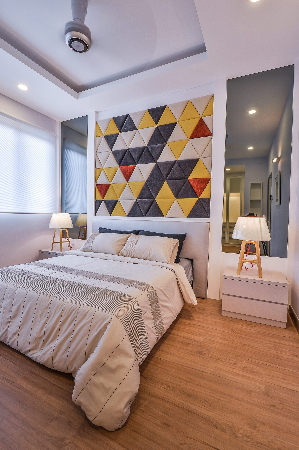
6 Stunning Bedroom Feature Walls for an Eye-Catching Effect
Friday, November 20, 2020
A bedstead framed with a decorative feature wall provides an additional layer of shade and texture to create a luxurious and comforting ambiance that simply cannot be matched by a plain wall.
An unadorned bedroom offers little more comfort than a communal dormitory with walls devoid of personalised imagery. For those who have found themselves having to contend with a distinctly bare bedstead, surrounded by an overabundance of empty space that inadvertently draws attention to the stark contrast between your choice of headboard and the plain white wall behind it - a decorative feature may be the very thing needed to make that bedroom yours.
 Interior design by: Design Base
Interior design by: Design Base
Incorporating a decorative feature wall into any space requires some forward planning, not just to ensure that the selected materials complement the décor, but also for the consideration of any added lighting and ventilating fixtures. To inspire your next decorative feature wall, we assembled some of our favourite designs for your reference here.
Differing Shades
 Interior design by: GDY Design & Construction
Interior design by: GDY Design & Construction
The simplest expression of creativity in a decorative feature wall can be achieved by positioning elements of different colours next to each other. While other colour combinations can be used to bold effect, a feature wall can be subtly expressed using just two shades of the neutral palette, with a central element of grey framed on either side with panels in beige for definition. The absence of complicated patterns on such a feature wall would be ideally suited for modern and minimalist interiors.
 Interior design by: GDY Design & Construction
Interior design by: GDY Design & Construction
Creative Expression
 Interior design by: Soul Frame Design
Interior design by: Soul Frame Design
Instead of adding another layer to the bedroom wall for a decorative feature, as the addition of a wall façade or decorative panel mounted on the wall occupies floor space, the feature wall of small bedrooms can be composed of painted murals or framed artwork. The result is a truly unique decorative feature that lends the ambiance a dose of eccentricity that and can be modified to suit to match changing moods.
 Interior design by: Soul Frame Design
Interior design by: Soul Frame Design
Decorative Alcove
 Interior design by: Deseo Creativo
Interior design by: Deseo Creativo
With some space to spare, a decorative feature wall adorned with even the simplest geometry can be taken to stunning heights in combination with a recessed ceiling in modern and minimalist interiors. Incorporating a full-height decorative feature wall that melds with a ceiling tray provides an additional plane to decorate and creates a comforting alcove over the bed.
Illuminated Panels
 Interior design by: Zids Design
Interior design by: Zids Design
Whatever the choice of material or design you decide on for your decorative feature wall, the presentation can be given a luxurious flair with the addition of lit accents bordering the central elements. Framing a decorative feature wall in light serves to increase its visual prominence and provides the bedroom with an indirect form of lighting. The lighting accents can be boxed in transparent materials for a dimmer result, or simply placed within recesses to provide a mounted panel with more depth.
Window Framed
 Interior design by: Latitude Design
Interior design by: Latitude Design
After space, the next most valuable commodity of homes would be uninterrupted views of the outside world. If your bedroom is blessed with an abundance of windows, consider incorporating them into the design of your feature wall. Although framing a decorative feature wall in windows is a difficult arrangement to achieve, with some custom carpentry and architectural tweaking, the result is a breath-taking view every time you wake up.
 Interior design by: Latitude Design
Interior design by: Latitude Design
Marbled Stone
 Interior design by: Hoe & Yin Design Studio
Interior design by: Hoe & Yin Design Studio
Rather than focusing on the design of decorative elements, one could just hand the task of artistic expression back to nature with a panel of cut stone mounted on heavy-duty brackets. The natural shades and marbled veins of stone create presentations that are often just as mystifying as the brushstrokes of abstract paintings, making this form of decoration equally suitable for modern or classical interiors.
 Interior design by: Hoe & Yin Design Studio
Interior design by: Hoe & Yin Design Studio
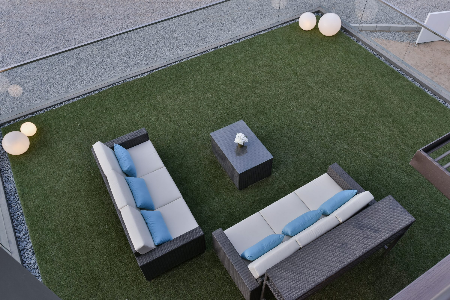
8 Lighting Ideas for Your Gardens and Patios
Friday, November 20, 2020
Beyond merely a consideration of safety or comfort, lighting fixtures in your garden can have truly inexplicable and magical effects on your outdoor spaces.
Appointing your outdoor spaces with lighting is more than just an affordable way of extending living areas or increasing the sense of security and comfort around the home - intriguing lighting fixtures may become the central component of the décor, serve to distribute attention away from a central feature, or intangibly frame a space for more subtle effects. If you find yourself spoilt for choice with the wide selection of various lighting fixtures available, take a look at the following eight inspiring ways of using lighting in outdoor spaces for some ideas.
Minimal Demarcation
 Design by: GDY Design & Construction
Design by: GDY Design & Construction
Applied more for decoration, the matching orbs of light pictured here are used to mark out the edges of the seating area without imposing on the view or the simplicity of the arrangement. As the sun disappears over the horizon, the radiating fields of illumination will accentuate the white fabrics of the seating to create an inviting mood that would have been otherwise overwhelmed by an abundance of lighting.
 Design by: GDY Design & Construction
Design by: GDY Design & Construction
Illuminated Background
 Design by: Latitude Design
Design by: Latitude Design
A wash of light is applied to render this contemporary poolside scene in a monochromatic palette: with a background dominated by an expanse of pale architectural finishes and lined with the dark frames of wood. The simple contrast in shade is complemented by a beach resort ambiance, created with the deliberate placement of lighting to focus attention on the pool and the tropical-style gazebo.
Central Focus
 Design by: Deseo Creativo
The modern gazebo occupies the central position of this outdoor space - indicated by an array of hanging pendant lights, while a border of downward-facing lamps illuminate the footpath around it. As the light emitted from the foot lamps rarely comes into direct contact with the eye, these lamps serve to subtly illuminate the background while the pendant lights narrow focus to the seating furniture.
Design by: Deseo Creativo
The modern gazebo occupies the central position of this outdoor space - indicated by an array of hanging pendant lights, while a border of downward-facing lamps illuminate the footpath around it. As the light emitted from the foot lamps rarely comes into direct contact with the eye, these lamps serve to subtly illuminate the background while the pendant lights narrow focus to the seating furniture.
 Design by: Deseo Creativo
Design by: Deseo Creativo
Indirect Lighting
 Design by: ID Industries
Design by: ID Industries
The poolside of this tropical home is dotted with lighting fixtures that are intended to frame decorative features rather than putting them in the spotlight. The decorative plaster plaques along the pool’s long edge are framed by modern fixtures that cast the light downward, while the shaded lamps hanging from the poolside canopy add to the serene mood.
Reflected Light
 Design by: Regal Violet
Design by: Regal Violet
Few fixtures - if any, can reproduce the mystifying effects of light given motion by way of ripples in water. This enigmatic effect is best served with waterproof lights submerged in or around water features, with relatively plain architectural finishes acting as a backdrop to receive the reflected light.
Luminous Frame
 Design by: Space In Design
Design by: Space In Design
Lighting fixtures arranged into a regular shape rarely produce a result that fits cohesively with a natural landscape - unless that polygon is used to frame a water feature, in which case the result is an enhanced body of water that invites a closer look. While light applied with deliberate geometry may appear out of place in tropical-themed gardens, the effects of lit right-angles complement the manicured gardens of modern urban homes.
Cold Fire
 Design by: Living Space Design
While warm white light is commonly understood as being the most appropriate quality of light for inducing relaxation, the occasional streak of cool white light provides a measure of stark emphasis for dramatic effect. When used in conjunction with a body of water, cool white light creates magical impressions of bluish flames that ripple with the motion of water.
Design by: Living Space Design
While warm white light is commonly understood as being the most appropriate quality of light for inducing relaxation, the occasional streak of cool white light provides a measure of stark emphasis for dramatic effect. When used in conjunction with a body of water, cool white light creates magical impressions of bluish flames that ripple with the motion of water.
Resort Ambiance
 Design by: IDS Interior
Design by: IDS Interior
You don’t necessarily have to spend any time lingering on a beachside resort to get some ideas on how to create a resort-like ambiance at home. Having been repeated countless times around the world, the formula for applying lighting to affect a resort-like outdoor space is fairly established: spotlights directed upwards at foliage, vertically-oriented cones of light along walls, and ethereal underwater lights along the edges of a water feature.
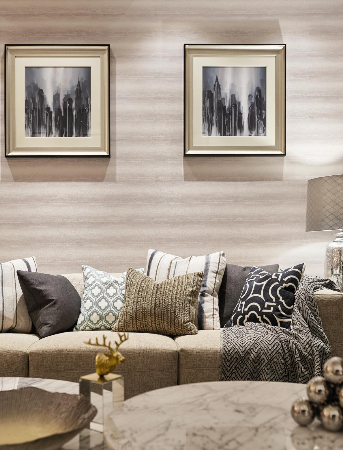
Styling With Patterns and Textures in Your Living Room
Friday, November 20, 2020
Through the use of fabrics, rugs, upholstery or solid surfaces, you can infuse a strong wow factor in your living room with patterns and textures.
Patterns and motifs add an immediate wow factor to living rooms - however they must be mixed and matched right. Whether you are introducing patterns and textures using fabrics, rugs, upholstery or solid surfaces, there are multitude ways to work with them to give your spaces their own unique personality.
 Interior design by: ST Concepts
Interior design by: ST Concepts
One of the key things to remember is that different patterns should have a common element so that they go together. It can be the same colour family, a similar style or complementing shapes. If you are doing this for the first time, the easiest way to ensure your different patterns go together is to use no more than 3 different motifs against a common palette.
Stay Neutral
 Interior design by: ST Concepts
Interior design by: ST Concepts
The neutral palette is a safe choice for a backdrop as it tends to bring a variety of patterns together without overwhelming the eye.
 Interior design by: ST Concepts
Interior design by: ST Concepts
In this living room, the designer successfully paired a variety of lush fabrics and textures together in a pleasing manner - thanks to the beige and off-white palette. To bring the eye to the furnishing pieces, pillows with geometric prints are used. Over on the feature wall, lines complement the decor while the polished marble surface of the coffee table gives the perfect finishing touch.
Pick a Hero Pattern
 Interior design by: Hoe & Yin Design Studio
Interior design by: Hoe & Yin Design Studio
Pick one pattern to be the hero, and use other patterns to complement it. The hero pattern can be something bolder and more dramatic. From here, it’s essential to create balance with more subtle prints or lighter colours.
 Interior design by: Hoe & Yin Design Studio
Interior design by: Hoe & Yin Design Studio
For this living room, a composition of interesting fabrics are used to create a lush effect. These fabrics serve as the complements for the hero feature in the room - the eye-catching wall-covering with two bright blue armchairs. The gray sofa and gray rug work well to offset the powerful patterns and tones used in this interior.
Mix Up the Textures
 Interior design by: Hoe & Yin Design Studio
Interior design by: Hoe & Yin Design Studio
Put different textures together to create an interesting ambience. Smooth surfaces can be softened up with cosy fabrics, while solid colours on the walls can be uplifted using flooring materials.
 Interior design by: Hoe & Yin Design Studio
Interior design by: Hoe & Yin Design Studio
This living room features a harmony of textures that blend in with the key furniture pieces. A single painting is effective in creating a secondary focal point while the addition of indoor plants also help to bring out a sense of freshness to the overall theme.
Tip: To find the perfect colour combo for your living room, use a colour wheel: hues that sit opposite each other on the sphere, like purple, orange, pink, and minty green, are guaranteed to look pretty when paired. And while bright shades can be exciting, remember that more neutral palettes have their own charm too.Repeat Motifs
 Interior design by: Surface R
Interior design by: Surface R
Using the same fabrics or textures may be monotonous, but when patterns are repeated, they can create a visual boost for your interior. If you are using a graphic pattern or something as simple as stripes, use it continuously within a single area to infuse your space with a focal point.
The partition is in this living room is the perfect example of using patterns in repetition. However, instead of just choosing a singular motif, the designer has gone for several similar motifs to create that patterned effect. What's interesting is the subtle addition of complementary prints in the form of pillows. There is also a second repetition of pattern on the wood finishing that envelopes the stairway.
[gallery link="none" columns="2" size="medium" ids="57465,57464"] Tip: When you want to shy away from bold and colourful patterns, texture is your best friend. Neutral is never boring when a variety of textures are used. Mix it up! Repeating the same pattern throughout a room is also a reliable way to achieve cohesiveness. Interior design by: Surface RGo Large
 Interior design by: Mode Interior Style
Interior design by: Mode Interior Style
If your living room is big and roomy, large-scale patterns are a good way to bring the space closer together. To avoid overpowering the interior with very strong patterns, use flooring so that it won’t visually steal attention away from your main furnishing pieces.
To introduce patterns, this home features a unique treatment of flooring styles. The laminate wood flooring is done up with irregular patterns that stand out prominently. To tone it down, smooth grey flooring is used next to it. The designer also added on a textural feature wall to create a distinctive focal point in this space.
Article by: Lily Wong
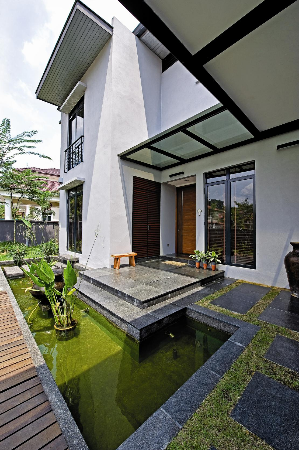
4 Ways to Cozy Up Your Outdoor Space
Friday, November 20, 2020
Even the outdoor spaces of a modern urban home can be transformed into private retreats with the consideration of this handful of factors.
 Design by: SQFT Space Design Management
Design by: SQFT Space Design Management
When the sun takes on a more enjoyable temperament in the evenings - or has yet to get fierce at the start of the day, there is perhaps nothing as enriching or rejuvenating for the soul as a meditative stroll in the sanctuary of one’s own garden. But perhaps your home came with a hardscape instead of a lawn, or your initial reaction to a blank slate devoid of grass cover was to lay your choice of architectural finishes over it instead - either way, you may have a potentially cold expanse of stone to contend with. To help imbue your gardens and balconies with some semblance of intimacy, we took a look at our favourite outdoor spaces and described the ingredients that make for restful retreats here.
Warm Lighting
 Design by: Metrics Global
Design by: Metrics Global
The subtle effects of light on our behavioural patterns are only just being uncovered presently, with the most recent findings implying that our natural rhythms leading to sleep are interrupted by artificial sources of blue light - which modern urban life seems to be saturated in, due to the prevalence of black mirrors and fluorescent lighting fixtures. One of the easiest ways to go about turning an emotionless outdoor space into one that is more hospitable is to exchange light bulbs of the “cool white” variety with the paradoxically lower temperature “warm white” bulbs. As with stars in the sky, bulbs burning at lower temperatures appear more red than blue - emitting a light that is similar to the quality of sunlight at the start and end of each day, when our natural rhythms are at their most restive.
 Image Credit: Nedgis Lighting
Image Credit: Nedgis Lighting
Inviting Furniture
 Image Credit: Isofu
Image Credit: Isofu
Even with a stone patio adequately appointed with warm yellow lighting and vibrant swathes of flora, without some form of seating available, there is not much to do other than to take in the scenery while standing. Adding a single chair provides a platform for a few solitary activities - but adding a table, and a few more chairs, provides opportunities for a gathering of intimate acquaintances in close proximity.
 Design by: Nu Infinity
Design by: Nu Infinity
 Design by: Nu Infinity
Design by: Nu Infinity
Facilitated Fun
 Design by: Nu Infinity
Design by: Nu Infinity
If you want to provide more than just a place for friends and family to converse while taking in the ambiance, consider incorporating additional features as conversation multipliers to ease restless personalities and fill uncomfortable silences. Talking points spontaneously arise around features such as an intriguing ornament, a potted plant, a rock garden, an artful water feature, or a fish pond; and the merriment of an outdoor soiree can be extended with the addition of a barbeque grill, a beverage bar, or if space permits: a decadent body of water such as a foot bath, a Jacuzzi, or a pool.
[gallery columns="2" size="medium" ids="57808,57810"]Characteristic Style
 Tip: To anchor a strong sense of style in your outdoor space, go for statement-making furniture. This beautiful piece from Les Asia's Skyline range is the perfect example with its sophisticated design and weather-friendly features. Image Credit: Les Asia
Tip: To anchor a strong sense of style in your outdoor space, go for statement-making furniture. This beautiful piece from Les Asia's Skyline range is the perfect example with its sophisticated design and weather-friendly features. Image Credit: Les Asia
The style of décor that is most appropriate for the creation of an intimate outdoor space is largely dependant on personal preferences and where one feels most at home on the continuum of order and chaos. Generally, a home with a large outdoor space would benefit from a strong focal point achieved using a stylish outdoor furniture piece.
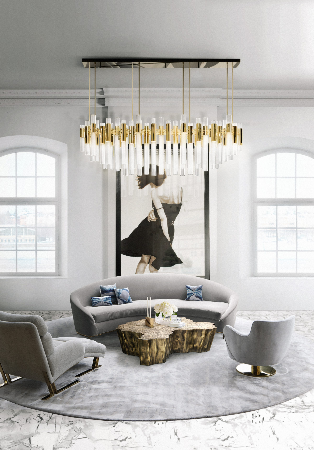
Living Room Lighting Ideas
Friday, November 20, 2020
Now that you have decided on your furnishings, it is time to think about putting your curation in a flattering light.
It would all be for naught, if you put in the time and effort to handpick your furnishings for a dramatic display in daylight - only for them to blend with the shadows when the sun sets. Unless the intended effect was a nocturnal disappearing act, you would want the results of your hard work displayed in full, attention-grabbing light for all to see. With the placement of a few thoughtfully-placed fixtures, even interiors that appear sombre in the evenings can be revitalised.
 Interior design by: Luxxu
Interior design by: Luxxu
While putting together your furniture arrangements, you may want to consider planning for lighting fixtures at the same time - as some forms of lighting require additional fixtures, wiring, or plasterwork in order to complete installations. In this guide, we take a closer look at the various forms of lighting available, their benefits, and the considerations that come with each.
Pendant Lights
 Interior design by: X-Two Concept
Interior design by: X-Two Concept
What minimalism has done to furniture can be seen in modern pendant lights - arguably the result of chandeliers being stripped of their trappings to retain the bare essentials in exposed bulbs. Pendant lights are most suited to modern and minimalist interiors, but are highly versatile with a wide range of styles due to their typically narrow profiles. The installation of pendant lights is not complicated by the weight of the fixtures, but rather by their typical composition in arrays of bulbs, requiring specialist wiring know-how to correctly chain bulbs together without running the risk of shorting out the electrical switchboard.
Spotlights
 Interior design by: Turn Design Interior
Interior design by: Turn Design Interior
For a dramatic cone of light around treasured decorations, consider installing a single spotlight with a narrow zone of effect directly overhead. The result is a gallery-like presentation that is better suited for highlighting specific objects rather than casting light over a wide area. For area effect lighting using spotlights, consider using a number of identical units arranged in a wide array, or selecting a set that includes a rail. Wiring considerations are similar to those for pendant lights, in that their installation is less often plug-and-play, more often requiring specialty adapters or dedicated wiring.
Wall Sconces
 Interior design by: GDY Design & Construction
Interior design by: GDY Design & Construction
Decorative lighting fixtures that are mounted to walls help to indirectly illuminate architectural finishes or to highlight decorative features nearby, however their placement is limited to points in a home where wiring has been provided. The installation of wall sconces, at least in locations that lack the requisite wiring points and corresponding switches, would entail the construction of wiring ducts along portions of walls - a process that typically results in a pervasive cloud of brick and concrete dust. If pre-existing conditions permit, consider using wall sconces in places where floor space is scarce.
Recessed Lighting
 Interior design by: Zids Design
Interior design by: Zids Design
One of the most subtly elegant ways to bestow a space with unobtrusive lighting is with LED strips embedded into the crevices and recesses of plaster ceilings. These lighting strips are typically used alongside white plaster ceilings as the pale surfaces serve to reflect light - in a manner very much like lampshades. The soft and indirect rays of light from recessed LEDs make for a low-profile fixture that blends well with styles ranging from classical to modern. The fixtures themselves are typically lightweight and uncomplicated to install, being made to plug into standard sockets - with the addition of adapters supplied by the manufacturers.
Chandeliers
 Interior design by: Design Integra
Interior design by: Design Integra
Even before electric lighting became a requisite household feature, crystal chandeliers have been used to suspend lighting sources high above the ground. The various crystal components are traditionally cut into specific designs to deliberately magnify and spread light out evenly across large spaces. Intricate crystal chandeliers of antique designs are still being used to appoint classically-inspired interiors, while newer offerings ranging in shape from modest to extravagant are better suited for more contemporary interiors. By virtue of their complicated construction, most chandeliers are hefty fixtures requiring the installation of ceiling hook plates to support the weight - meaning that the placement is limited to load-bearing beams or structural slabs rather than thin plaster ceilings.
Floor Lamps
 Interior design by: Sachi Interior Design
Interior design by: Sachi Interior Design
If you have the floor space to spare, floor lamps are ideal for casting light over a moderately wide area, working best in corners where the light they emit can be multiplied with the aid of pale or reflective surfaces. As floor lamps are not usually fixed, their positions can be changed to adapt with an evolving arrangement - and their production ensures that all is needed to power one is a domestic power outlet.
Table Lamps
 Tip: For a cohesive arrangement: select a table lamp that complements the space, providing a point where the materials and colours of the décor can converge. The pictured modern table lamps highlight the use of reflective metal accents and cream upholstery in the seating lounge, bringing the common materials to a corner of the space. Interior design by: SQFT Space Design Management
Tip: For a cohesive arrangement: select a table lamp that complements the space, providing a point where the materials and colours of the décor can converge. The pictured modern table lamps highlight the use of reflective metal accents and cream upholstery in the seating lounge, bringing the common materials to a corner of the space. Interior design by: SQFT Space Design Management
With an available table surface, a large portion of your lighting needs can be served with the simple placement of table lamp. Perhaps the most cost-effective solution for limited lighting, table lamps are often designed to act as decorative pieces on their own.

Trendy Features for a Highly Efficient Kitchen
Friday, November 20, 2020
A good-looking kitchen should be hard-working as well. Here are few designer tips to show you how to create an efficiently elegant kitchen.
You may want a large kitchen, thinking that the more spacious it is, the more space you have to work with. That's a misperception because when it comes to efficiency, a high performance kitchen is one that has everything you need within easy reach. So whether you have a big cookspace or a mini open kitchen, the important thing is to have both the task area and storage space at strategic locations.
 Image Credit: Rackbuddy
Image Credit: Rackbuddy
One way to achieve this is to have a well-planned kitchen. Make sure there's comfortable space to move around but ensure appliances are not so far apart, you seem to be running around constantly. Another way to enhance the efficiency of your kitchen space is to incorporate storage spaces that help to keep frequently-used tools at convenient spots while stowing away things that would clutter your countertop.
Hanging Out
 Image Credit: Rackbuddy
Image Credit: Rackbuddy
Think about using the space between the kitchen counter and the ceiling to keep your cooking tools. Hover a floating shelf to store your saucepans and pots, or even wine glasses, as these usually take up a lot of space to store in the cabinets. The best spot is above a kitchen island over your sink. In this example, the designer has gone for a unique hanging rail with cables and hooks. It's also fitted with little bulbs to give it a functional yet fashionable appeal. Everything else is kept pristinely white to maintain a chic and contemporary look.
Close Proximity
 Interior design by: Casa Indah Design
Interior design by: Casa Indah Design
Plan your cabinets according to how you use them. Tuck appliances neatly into the built-in cabinet and ensure you have optimal countertop space. Situate items that you commonly use together near to each other. Even simple touches such as elevating and organizing your spice collection so that it’s easy to see can improve your experience of using your kitchen.
 Interior design by: Casa Indah Design
Interior design by: Casa Indah Design
Thanks to its well-placed elements, this kitchen is clean, minimalist, and has an inviting look. The designer has made good use of the available space, which reduces clutter. The addition of the yellow backsplash is a nice touch to give this kitchen a bright focal point.
 Interior design by: Casa Indah Design
Interior design by: Casa Indah Design
Cabinet Concepts
 Interior design by: Architrio Design
Interior design by: Architrio Design
When it comes to planning your cabinets, keep in mind the ease of use. Go for cabinets that create a seamless transition. This is highly important if it's an open kitchen that looks out towards the main living area. Ensure the entire theme and palette are cohesive.
White cabinets with wood outlines and sleek accents blend beautifully with the living room of this bungalow. Everything has also been designed for maximum convenience. Note how the ovens and the refrigerator are designed as part of the cabinets, while a breakfast nook helps to demarcate the kitchen area.
 Interior design by: Architrio Design. Tip: Linear forms in the kitchen afford a visually clean and sophisticated outlook. These streamlined shapes can also be used as benches and concealed storage units to make the kitchen more efficient.
Interior design by: Architrio Design. Tip: Linear forms in the kitchen afford a visually clean and sophisticated outlook. These streamlined shapes can also be used as benches and concealed storage units to make the kitchen more efficient.
Multifunctional Integration
As the hardest working space in the house, the kitchen will clutter easily. Each time you cook, you would need many different tools and gadgets, and these quickly fill up your counter space. One of the best ways to make sure you have all you need yet maintain a clean and clutter-free cookspace is to integrate and conceal different features within your cabinet design.
 Interior design by: Hugi-Küchen AG
Interior design by: Hugi-Küchen AG
This kitchen is the perfect example of how an integrated kitchen works. With its high gloss white and black glass, this kitchen features floor to ceiling units that provide plenty of storage spaces while accommodating the sink, ovens, microwave and coffee machine all on one wall. There is an island unit created with black glass units and white Corian top. Special glass fronts reflect the light creating an ambience of lightness and transparency. The sink area is also enhanced with under-mounted lighting.
Streamline Style
[gallery columns="2" size="medium" ids="57797,57796"]For smaller kitchens where you don't have the luxury of a lot of countertop space, go for under counter storage spaces and opt for wall cabinets. It's also important not to store too many things on the countertop. If possible, opt for a built-in pantry spaces to store your groceries. Otherwise you may want to consider a second wet kitchen.
[gallery columns="2" size="medium" ids="57798,57795"]In this condo's open kitchen, a linear kitchen helps to maintain a sense of spaciousness. Cabinets are also kept sleek and clean. The addition of the breakfast table in the centre offers extra work space and adds on a creative touch to the overall setting.
Article by: Lily Wong
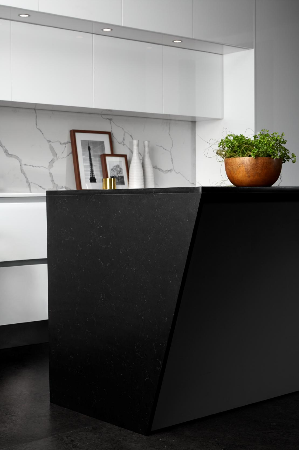
How to Choose the Correct Kitchen Finishes and Materials
Friday, November 20, 2020
Whether you are decorating for durability or for eye-pleasing aesthetics, there are a multitude of factors to consider when selecting materials and finishes for your kitchen.
 Interior design by: Signature Kitchen
Interior design by: Signature Kitchen
At first glance, a kitchen in the making may only evoke concerns over its final appearance, but there's to more to it than meets the eye. Materials and finishes play an important role as well when it comes to the countertops, cabinetry, paint and backsplash features. Whether your style is traditional, transitional, or modern, focus on an overall theme as one of the first steps to selecting your materials. Aside from colour, it's also important to consider tone and texture to create an overall design that does not appear visually flat when the project is completed.
Laminates
 Interior design by: Regal Violet
Interior design by: Regal Violet
Being made of highly-compressed layers of wood and fabric soaked in resins, laminates provide a greater range of possible shades - in addition to the aesthetic quality of natural wood, combined with the relative durability of plastic resins. Laminates of the past may have garnered a reputation for being susceptible to high humidity and temperatures, but recent developments in the refinement of plastics have resulted in more accessible and durable laminates that are less likely to peel with moisture and age.
Natural Stone
 Interior design by: IDS Interior
Interior design by: IDS Interior
The irreproducible shades and veins of quarried stone panels make for truly unique countertops that project an image of individuality and prosperity - but being a material acquired from natural sources, quarried stones of matching shades are notoriously difficult to acquire in consistent quantities, making planning and acquisition the most crucial stages in the renovation of a kitchen with stone surfaces. The workability of stone does not compare to the ease of working with wood however, as various types of stone have an inherent propensity to chip in response to impact or crack from vibrations - which entails uniform sizes of panels and finishing details such as edge cuts to be affected by an experienced craftsperson.
Wood
 Interior design by: Q1 Interior Concept
Interior design by: Q1 Interior Concept
Natural wood, especially those selectively harvested from managed plantations, represent an increasingly popular choice among the ecologically conscientious and anyone seeking to recreate a cooking space from a simpler time. Wood is the simplest material to work with, and some of us may be immediately drawn to materials such as reclaimed wood planks to bedeck a kitchen in country style, but the porosity and propensity to absorb water in even the densest of hardwoods is cause for caution. Despite the physical drawbacks, the occasional authentic wooden element makes for a dramatic and nuanced contrast when presented in conjunction with other materials such as stone or steel.
Tiles
 Interior design by: ST Concepts
Interior design by: ST Concepts
While cutting, shaping, and polishing natural stone by hand is an art unto itself, the use of ceramic or porcelain tiles, or even pre-cut stone pieces, make the aesthetics of stone more accessible. Modern tiles can be manufactured to mimic the shades and patterns of natural stone, or to introduce designed patterns and colours, often rolling out of industrial ovens with varieties of matte or glossy sheens already baked in. As they are manufactured materials, most tiles composed of ceramic or porcelain require little to no chemical treatment after installation - however, much like pre-cut stone tiles, ceramic and porcelain tiles must be bordered with grout to adhere the tiles and prevent them from impacting each other.
Stainless Steel
 Interior design by: Creative Steel
Interior design by: Creative Steel
Any commercial entity with its livelihood based on the preparation of food depends on a kitchen furnished with stainless steel surfaces. The accessibility, durability, and chemical resistance of steel are unmatched by all other materials - with the sole exception of quartz. High-gauge stainless steel is strong, yet thin enough to be easily workable, but countertops will show visible dents without a cushioning layer of hardwood to absorb impacts. Besides providing a reflective sheen that complements modern kitchens and visually expands compact spaces, stainless steel is a practical choice for countertops as it is able to withstand high temperatures without conducting heat away from the source.
Cement
 Interior design by: Homlux Interior Furnishing
Interior design by: Homlux Interior Furnishing
Where stone and tiles typically restrict designs to dimensions predetermined by suppliers and manufacturers, the use of cement to render surfaces opens the door on all kinds of creative expressions in post-industrial style. Much like natural stone, cement is susceptible to impact damage and has a porosity that must be addressed by the application of chemical treatments to prevent stains. Without a sealing coat, cement surfaces tend to appear matte when cured, with a tendency towards displaying unpredictable streaking of limescale when fully dried. Aged cement surfaces accumulate an irreproducible polish and characteristic patina over time, a feature that is warming and comforting to those seeking a vintage-industrial décor.
Engineered Quartz
 Interior design by: Turn Design
Interior design by: Turn Design
With engineered stone surfaces such as quartz, the shades and veins of natural stone are made more accessible with recent improvements in adhesives. Unlike naturally quarried stone, engineered quartz is non-porous and much more readily available - being composed of synthetic polymers and otherwise unused flecks from the same quarries supplying the world’s most recognizable types of marble. The majority of the blend being quartz - one of the Earth’s hardest minerals, the finished product is a surface that withstands more physical damage, chemicals, as well as fluctuations between temperature extremes, even when compared with the densest of natural stones. Consequently, it is also one of the most difficult materials to work with, limiting the supply and installation of this material to a select network of manufacturers and applicators.
Solid Surface
 Interior design by: Design Integra
Interior design by: Design Integra
Much like cement, solid surfaces can be seamlessly rendered in curved profiles while the material is still in its uncured slurry state. Unlike cement, solid surfaces are shaped at the point of manufacture much like quartz panels are, but their inherent workability permits shaping during installation and repairs by grinding or polishing. Being manufactured in a similar manner as quartz, the designs and shades of solid surfaces among the world’s various suppliers are highly varied - but while quartz can be identified as being composed of a single type of mineral, solid surfaces may be based on softer minerals, or contain a mixture of minerals to achieve a balance of aesthetics and workability.
Glass
 Interior design by: Homlux Interior Furnishing
Interior design by: Homlux Interior Furnishing
If the reflective quality of stainless steel seems to fall short of expectations, consider using glass on the backsplash, or to finish the fronts of cabinets instead. Whether opaque or transparent, glass adds a delicate layer of modern elegance to kitchens - especially when used in conjunction with other disparate materials such as wood, stone, or steel. Glass panes can also be used to protect porous materials such as wood or stone from moisture and stains by being fixed over the more absorbent materials. The aesthetic qualities of glass do come with a rather widely-understood caveat: being a crystalline structure locked in a stable state by heat and pressure, glass is susceptible to impact damage and extreme temperature fluctuations -necessitating caution in its use on surfaces where heavy objects such as pots and pans are likely to land with some force.
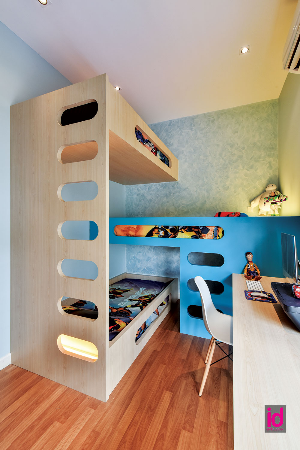
Playful Palettes: How to Create a Themed Bedroom for Boys
Friday, November 20, 2020
If you've read our tips on how to decorate bedrooms for children, you may also be interested in how to affect gender-specific themed decors for boys. We gathered our panel of interior designers to take a look at the composition of children's bedrooms and arrived at the following list of essential ingredients for a boy's themed bedroom.
Wall Colours The nautical theme is often the fall-back decor for most parents with young children, leading to the common use of various shades of blue to depict the sky and sea. Most boys bedrooms sport a palette dominated by blues, which work well as a background for a variety of animated characters.
 The walls of this bedroom are saturated in sky-blue, serving as a background for the figurines distributed about the space. Designer: Surface R
The walls of this bedroom are saturated in sky-blue, serving as a background for the figurines distributed about the space. Designer: Surface R
Bedspread The fabrics used on the bed can go a long way towards contributing to a theme by virtue of their size. Take special care to select a bedspread that is not only colourful, but also matches the other decorative features of the space in order to solidify a theme.
 The bedspreads are the sources of the most vivid colours in this bedroom, providing the most obvious indication of the occupants' genders. Designer: Q1 Interior Concept
The bedspreads are the sources of the most vivid colours in this bedroom, providing the most obvious indication of the occupants' genders. Designer: Q1 Interior ConceptMurals Perhaps the most definitive element of any themed bedroom is the central decorative element. Instead of using subtle lines and subdued colours as in adult bedrooms, consider instead a bright and colourful painted mural over the headboard to serve as the theme's centrepiece.
 This boy's bedroom embodies the superhero theme, combining various shades of blue in drapery and furnishings with characters from the Marvel Comics Universe above the fabric headboard, while images of DC Comics' Superman occupies the bedspreads. Designer: We Interior
This boy's bedroom embodies the superhero theme, combining various shades of blue in drapery and furnishings with characters from the Marvel Comics Universe above the fabric headboard, while images of DC Comics' Superman occupies the bedspreads. Designer: We Interior
Accessories Adding decorative accents to a boy's space can help bring the theme to a head. The usual accessories would be favoured toys, but more mature boys may prefer sports equipment or recreational facilities.

This room forgoes shades of blue entirely in favour of an energizing yellow. The sports theme is affected by the mural of a soccer player. Designer: Design Base
Storage Shelving can be made to fit particular themes in their designs, making it another viable point of focus when affecting a themed bedroom. Even at young ages, boys can pick up valuable life skills and train for adulthood while putting toys away and sitting down at desks for work.
 This bedroom includes shelving and a desk, complete with drawers for additional storage. Designer: Space Matrix
What about room for girls? Here are some tips.
This bedroom includes shelving and a desk, complete with drawers for additional storage. Designer: Space Matrix
What about room for girls? Here are some tips.
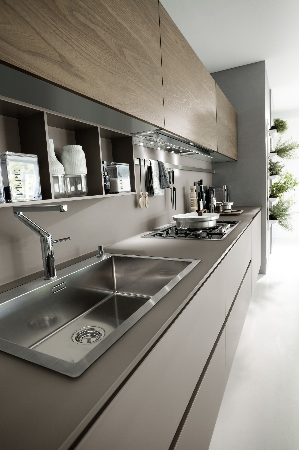
5 Types of Kitchen Layouts to Consider
Friday, November 20, 2020
When thinking on the type of kitchen layout to use, consider the dimensions of the space, the intended formality of your average dining experience, and the number of potential cooks in your home.
Kitchens are perhaps the busiest parts of most households, especially in family homes that serve up three square meals a day to multiple generations of diners. Due to the typically compact floor space of urban homes, and the list of modern appliances required for a convenient and full meal, furnishing a kitchen of any size likely entails a greater degree of forward planning than any other part of the home.
 Interior design by: Pedini Cucine
Interior design by: Pedini Cucine
Whether you are renovating your present kitchen, or looking at a fresh slate, deciding on the kind of configuration you want for your cabinetry and countertops would be the first step towards furnishing your kitchen - as these bulky elements will be sheltering your appliances and will represent the metaphorical backbone of your décor.
Single-Wall
 Interior design by: ID Industries
Interior design by: ID Industries
Often used in studios apartments and smaller homes with open layouts, the single-wall configuration is ideal for taking up the least amount of wall space, especially in areas that serve multiple purposes, such as conjoined dining and kitchen spaces. As the refrigerator, sink, and stove top are located in a line, this layout is typically seen as suitable for homes with only one potential cook, but modern examples of the single-wall layout are often seen accompanied by a compact dining surface, or an island for cabinetry, to provide additional workspace, storage, and to serve as a form of separation between the culinary space and the rest of the home.
 Interior design by: Surface R
Interior design by: Surface R
Galley
 Interior design by: Jashen Interior
Interior design by: Jashen Interior
The standard layout found in commercial kitchens on land, sea, and in the air - the galley layout is preferred for the most economical arrangement of the necessary amenities in the smallest of spaces between two parallel walls. While this layout provides a walkway through the kitchen, and allows one to keep serving ware away from the potential chaos of the work triangle, the galley configuration does not typically leave enough space for a dining nook, and the enclosing walls may represent a distinct barrier to interactions between chef and diner.
L-Shaped
 Interior design by: The Roof Studio
Interior design by: The Roof Studio
The stereotypical layout of the average kitchen, the L-shaped configuration can be formed out of a single-wall layout with the addition of an island, or with two lengths of countertops joined at a corner. This layout enables the most compact work triangle between the necessary culinary facilities while providing foot traffic space for additional cooks and wandering dinner guests. As the L-shaped layout results in an abundance of leftover floor space, this configuration provides the possibility of adding a sizable dining surface, or additional work space in the centre of the room.
 Interior design by: Surface R
Interior design by: Surface R
U-Shaped
 Tip: A generously sized kitchen is required for a U-shaped configuration to not seem cramped, as the inside corners formed by cabinetry take up significant floor space. Interior design by: Viincology
Tip: A generously sized kitchen is required for a U-shaped configuration to not seem cramped, as the inside corners formed by cabinetry take up significant floor space. Interior design by: Viincology
With the U-shaped layout, the work triangle covers a much greater distance, often negating the possibility of adding dining surfaces to the centre of smaller kitchens. A wide kitchen is needed to accommodate the extra space needed by corner cabinetry, but despite typically requiring spaces of greater dimensions, the U-shaped configuration enables an uninterrupted view of the rest of the home in an open layout. With the addition of a kitchen island either projecting from a wall or located in the centre, the U-shaped layout can be converted into a G-shape for a casual dining surface and additional work space facing the rest of the home.
L-Shaped with Island
 Interior design by: Desigva Interior
Interior design by: Desigva Interior
In a home with an open layout, the typical L-shaped configuration leaves a cook unceremoniously facing the walls and corners. With the addition of an island projecting from the wall, or positioned in the centre of the room, diners can be accommodated for casual eat-in sessions, and face-to-face conversations can be held while preparing a meal on the extra work surface. Adding a projecting island counter to an L-shaped configuration changes a distinctly open layout to one that separates the kitchen from the rest of the home.
[gallery columns="2" size="medium" ids="57690,57691"]Tip: The standard L-shaped configuration leaves some room for a projecting island - not just to subdivide and enclose the space, but also to enable the chef to engage in face-to-face conversation with any dinner guests who wander into the kitchen.





